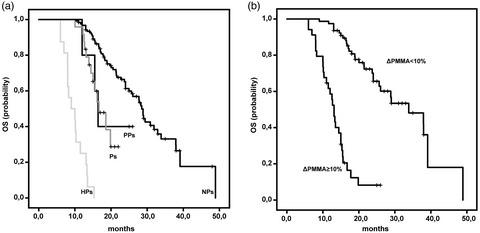当前位置:
X-MOL 学术
›
Clin. Exp. Immunol.
›
论文详情
Our official English website, www.x-mol.net, welcomes your
feedback! (Note: you will need to create a separate account there.)
Sarcopenia and high NLR are associated with the development of hyperprogressive disease after second-line pembrolizumab in patients with non-small-cell lung cancer.
Clinical & Experimental Immunology ( IF 3.4 ) Pub Date : 2020-08-05 , DOI: 10.1111/cei.13505 M P Petrova 1 , I S Donev 1 , M A Radanova 2 , M I Eneva 3 , E G Dimitrova 4 , G N Valchev 5 , V T Minchev 6 , M S Taushanova 6 , M V Boneva 7 , T S Karanikolova 1 , R B Gencheva 1 , G A Zhbantov 1 , A I Ivanova 1 , C V Timcheva 1 , B P Pavlov 8 , V G Megdanova 9 , B S Robev 10 , N V Conev 4
Clinical & Experimental Immunology ( IF 3.4 ) Pub Date : 2020-08-05 , DOI: 10.1111/cei.13505 M P Petrova 1 , I S Donev 1 , M A Radanova 2 , M I Eneva 3 , E G Dimitrova 4 , G N Valchev 5 , V T Minchev 6 , M S Taushanova 6 , M V Boneva 7 , T S Karanikolova 1 , R B Gencheva 1 , G A Zhbantov 1 , A I Ivanova 1 , C V Timcheva 1 , B P Pavlov 8 , V G Megdanova 9 , B S Robev 10 , N V Conev 4
Affiliation

|
The aim of this multi‐center retrospective study was to evaluate the incidence of hyperprogressive disease (HPD) after second‐line treatment with pembrolizumab in patients (n = 167) with metastatic non‐small‐cell lung cancer (NSCLC) whose tumors expressed programmed cell death ligand 1 (PD‐L1) in ≥ 1% and to search for hematological and imaging biomarkers associated with its development. Prior to chemotherapy, neutrophil : lymphocyte ratio (NLR1) and platelet : lymphocyte ratio (PLR1), and prior to immunotherapy, NLR2 and PLR2 were retrospectively analyzed. The psoas major muscle area (PMMA) was calculated at the L3 position on computed tomography before chemotherapy (PMMA1) and before immunotherapy (PMMA2) (n = 112). Patients with ∆PMMA (1‐PMMA2/PMMA1) × 100 ≥ 10% were considered to have sarcopenia (low muscle mass). After treatment with pembrolizumab on the first computerized tomography (CT) scan evaluation, patients were subdivided as follows as: hyperprogressors (HPs), progressors (Ps), non‐progressors (NPs) and pseudoprogressors (PPs). HPs had significantly higher ∆PMMA levels, NLR2 and PLR2 than the other patients. Moreover, in multinomial logistic regression analysis, higher levels of ∆PMMA were associated with a decreased likelihood of being a P [odds ratio (OR) = 0·81; 95% confidence interval (CI) = 0·65–0·99; P = 0·047] or an NP (OR = 0·76; 95% CI = 0·62–0·94; P = 0·012) versus an HP. Higher NLRs tended to decrease the likelihood of being a P versus an HP (OR = 0·66; 95% CI = 0·42–1·06; P = 0·09) and significantly decreased the likelihood of being an NP versus an HP (OR = 0·44; 95% CI = 0·28–0·69; P < 0·0001). Our data suggest that a high pre‐immunotherapy NLR2 and the presence of sarcopenia are potential risk factors for the development of HPD.
中文翻译:

非小细胞肺癌患者接受二线帕博利珠单抗治疗后,肌肉减少症和高 NLR 与超进展性疾病的发展有关。
这项多中心回顾性研究的目的是评估 转移性非小细胞肺癌 (NSCLC)患者 ( n = 167) 的肿瘤表达程序性细胞死亡配体 1 (PD-L1) ≥ 1% 并寻找与其发展相关的血液学和成像生物标志物。化疗前,中性粒细胞:淋巴细胞比(NLR1)和血小板:淋巴细胞比(PLR1),免疫治疗前,NLR2和PLR2进行回顾性分析。在化疗前 (PMMA1) 和免疫治疗前 (PMMA2) 的计算机断层扫描 L3 位置计算腰大肌面积 (PMMA) ( n = 112)。ΔPMMA (1-PMMA2/PMMA1) × 100 ≥ 10% 的患者被认为患有肌肉减少症(低肌肉质量)。在第一次计算机断层扫描 (CT) 扫描评估中使用 pembrolizumab 治疗后,患者细分如下:超进展者 (HPs)、进展者 (Ps)、非进展者 (NPs) 和假进展者 (PPs)。HPs 的 ∆PMMA 水平、NLR2 和 PLR2 显着高于其他患者。此外,在多项逻辑回归分析中,较高水平的 ∆PMMA 与成为 P [优势比 (OR) = 0·81;95% 置信区间 (CI) = 0·65–0·99;P = 0·047] 或 NP(OR = 0·76;95% CI = 0·62–0·94;P = 0·012)与HP。较高的 NLR 往往会降低成为 P 的可能性与HP相比(OR = 0·66;95% CI = 0·42–1·06;P = 0·09)并且与HP相比显着降低了成为 NP 的可能性(OR = 0·44;95% CI = 0·28–0·69;P < 0·0001)。我们的数据表明,高免疫治疗前 NLR2 和肌肉减少症的存在是发生 HPD 的潜在危险因素。
更新日期:2020-08-05
中文翻译:

非小细胞肺癌患者接受二线帕博利珠单抗治疗后,肌肉减少症和高 NLR 与超进展性疾病的发展有关。
这项多中心回顾性研究的目的是评估 转移性非小细胞肺癌 (NSCLC)患者 ( n = 167) 的肿瘤表达程序性细胞死亡配体 1 (PD-L1) ≥ 1% 并寻找与其发展相关的血液学和成像生物标志物。化疗前,中性粒细胞:淋巴细胞比(NLR1)和血小板:淋巴细胞比(PLR1),免疫治疗前,NLR2和PLR2进行回顾性分析。在化疗前 (PMMA1) 和免疫治疗前 (PMMA2) 的计算机断层扫描 L3 位置计算腰大肌面积 (PMMA) ( n = 112)。ΔPMMA (1-PMMA2/PMMA1) × 100 ≥ 10% 的患者被认为患有肌肉减少症(低肌肉质量)。在第一次计算机断层扫描 (CT) 扫描评估中使用 pembrolizumab 治疗后,患者细分如下:超进展者 (HPs)、进展者 (Ps)、非进展者 (NPs) 和假进展者 (PPs)。HPs 的 ∆PMMA 水平、NLR2 和 PLR2 显着高于其他患者。此外,在多项逻辑回归分析中,较高水平的 ∆PMMA 与成为 P [优势比 (OR) = 0·81;95% 置信区间 (CI) = 0·65–0·99;P = 0·047] 或 NP(OR = 0·76;95% CI = 0·62–0·94;P = 0·012)与HP。较高的 NLR 往往会降低成为 P 的可能性与HP相比(OR = 0·66;95% CI = 0·42–1·06;P = 0·09)并且与HP相比显着降低了成为 NP 的可能性(OR = 0·44;95% CI = 0·28–0·69;P < 0·0001)。我们的数据表明,高免疫治疗前 NLR2 和肌肉减少症的存在是发生 HPD 的潜在危险因素。











































 京公网安备 11010802027423号
京公网安备 11010802027423号